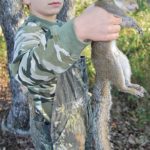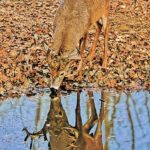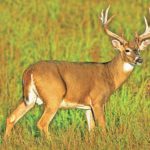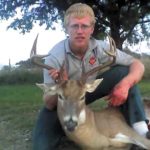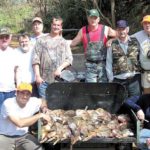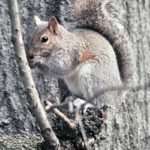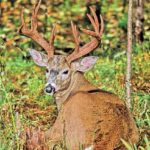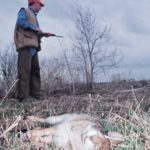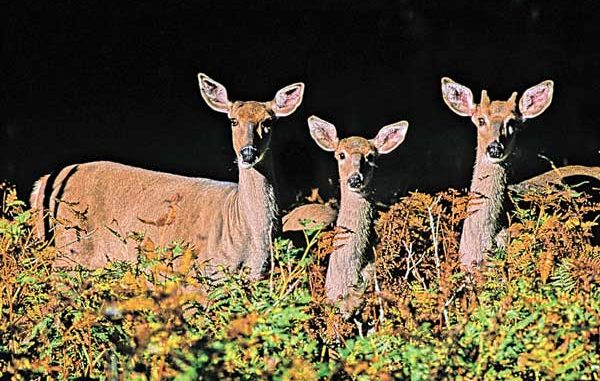
All of Louisiana’s WMAs host deer, squirrels and rabbits, but some are better than others. Follow the advice of the experts to put yourself on the hottest WMAs this season.
Dramatic changes in the “muzzleloader” deer hunting season, now known as the “primitive weapons” season, high gas prices and extensive flooding in one region of the state are among the headlines before hunters pick up their shotguns, rifles, compound bows and crossbows to hunt their favorite game — big or small — in 2008-09. The story with the most impact, one that chafed primitive-weapon purists, was Act 51, approved by the 2008 Louisiana Legislature. It ushers a new class of firearms into what used to be the state’s muzzleloader season, in which rifles or shotguns using blackpowder and loaded only from the muzzle were allowed.
The new law describes primitive weapons as “a single shot, breechloading, metallic-cartridge rifle with metallic cartridges loaded with either blackpowder or modern smokeless powder .38-caliber or larger, of a kind or type manufactured prior to 1900 and replicas and reproductions or reintroductions of that type rifle having exposed hammer. The pre-1900 distinction applies only to the firearm and not the ammunition.”
New regulations were posted in late June. That opened a floodgate of questions with many asking what is and what isn’t considered a primitive weapon. The Louisiana Wildlife and Fisheries Commission settled those questions.
Approved single-shot breech-loading primitive weapons are Sharps rifles or replicas; Remington Rollingblock rifles or replicas; Ballard rifles; Maynard rifles; Burnside carbines; Frank Wesson rifles; Remington Hepburn rifles; M1873-1888 Springfield rifles and carbines; Snider rifles and replicas; Wesson & Harrington 1871 rifles; New England Firearms or Harrington & Richardson Handi rifles in caliber larger than .38; Winchester M1885 Hi Wall or Lo Wall rifles or replicas (also Browning 878 or 1885), .38 or larger; Knight KP-1 in caliber .38 or larger; CVA Optima Elite in caliber .38 or larger and Traditions Pursuit break-open single shot in .38 caliber or larger.
Many of those firearms will be used on WMAs in Louisiana, generally regarded as some of the best in the country and managed by dedicated wildlife biologists, supervisors and managers from Regions 1 to 7.
Thankfully, few WMA biologists, supervisors and managers have to contend with too much water. Prolonged Mississippi River flooding this spring was an unwelcome natural event in Louisiana along a swollen stretch of the Mississippi River.
John Leslie, who has worked as a game biologist 17 years in Region 4, and others are wondering how much the high water will affect the hardest-hit WMAs — Red River and Three Rivers — and to a lesser extent on the southern portion of Bouef. The first two areas suffered 80 percent and 50 percent flooding, respectively, and the batture area of those two sites was under water 10- to 12-feet deep.
“We’re going to be facing a really unique situation this year because of extensive flooding. Both of those areas were severely impacted by the extensive and very deep flooding we had,” Leslie said.
The Mississippi River stage at Natchez, Miss., the gauge used for that region, crested around 57.0 feet, according to Leslie.
“Actually it went up and down twice,” he said. “The first time was really extensive. At its highest, river water levels stayed there three weeks to a month, and various portions of it flooded for probably two months. Those two areas, it’s going to be a very interesting thing to see what happens.”
The good news is there wasn’t a loss of wildlife, except for feral hogs.
“Obviously, wildlife in those two areas have been programmed over the centuries — as you know, the Mississippi River has flooded for centuries — wildlife are programmed to go to high ground. But this year was so extreme, lots of those traditional high-ground areas were flooded themselves,” Leslie said. “The bigger wildlife, such as deer and feral hogs and turkeys, they obviously left if they could. It’s just going to be a question how long it takes them to filter back to their original home ranges. They do come back very quickly. Others drift back over a period of 12 months.
“The only loss of wildlife we heard of were quite a few feral hogs didn’t make it out. We had several reports from guys who were boating around these areas and they saw quite a few hog carcasses.”
A concern is the condition of the deer that do return to Red River and Three Rivers WMAs. Deer must put a lot of energy into escaping a flood, which reduces body weights.
Most of the flooding occurred before the traditional fawn drop in the affected areas, the biologist said, “but that doesn’t mean the does weren’t affected by the flood.”
“A doe that’s in serious physiological distress will reabsorb a fetus, literally will not give birth that year. There’s a possibility some of that happened,” he said.
One significant flooding effect on Bouef WMA was the delay of construction of a waterfowl levee upgrade project on the southern end in the Crowe Field of the WMA. Leslie noted that a completed rock weir structure designed to relieve water pressure on the earthen levees of the project area was successful.
There is a positive note to the flooding in District 4, according to Leslie.
“All of those areas that were under the water have some brand-new vegetation growth that deer and turkey and hogs like to eat, so when we get on over into September, those areas are still going to have green succulent vegetation,” he said.
Granted, he said, it was the worst flooding the district has experienced since 1973.
“Two or three years from now, we may not see any effects of this flooding in the wildlife populations,” he said.
Steve Hebert, biologist manager in Region 1, doesn’t have to contend with flooding aftermath. However, he wondered aloud what high fuel prices might do to the sport. A gallon of gas in mid-July cost around $4.
“I am curious to see how the high cost of gasoline will influence the numbers using the WMAs, especially our friends in Cajun Country who travel up to Louisiana’s Great Northwest Hill Country. We hope they manage to keep up with their hunting traditions,” Hebert said. “I’ve heard from several already who are not sure how many times they’ll be able to drive up from South Louisiana, even local hunters.”
Planning a longer stay may help, he said. Getting a deer in the bag early is another plus, he said.
He is hopeful those deer-hunting traditions stay strong and vibrant.
“Hunters should try and enjoy the few days in the year they get to spend in the woods,” he said.
One of his peers said much the same thing.
“We’re kind of concerned about not having as many people on WMAs for either-sex hunting. It’s something we’ve been talking about — with the price of gas, if people are still willing to travel,” said Region 6 biologist manager Tony Vidrine. “People will still come to hunt. I don’t know if it’s going to affect us too much.”
For sure, many fishermen adjusted their schedules over the late spring and summer months in deference to the astronomical price of gas. For certain, they know that some fine hunting for rabbits, squirrels and deer awaits them on many public lands in the Sportsman’s Paradise.
REGION 1 OUTLOOK
A mild winter, a “mild” summer and some rainfall coming in the nick of time in most areas add up to one encouraging development: The streak continues for District 1.
That means habitat conditions in all the region’s parishes are promising going into the next hunting season, according to Region 1 biologist manager Steve Hebert. He likes the way the table has been set for 2008-09.
Although a few localized areas were getting pretty dry in mid-July, there was just enough rain to prevent a major drought there. Rainfall, in fact, was at least average in the spring and early summer. Hebert said.
And did he say “mild” summer? Yes, he did.
“Northwest Louisiana has not recorded a single 100-degree day as of July 17, which in my book makes for a pretty mild summer so far,” he said. “It looks like it’s fixin’ to heat up here, but it hasn’t been bad.”
The region also was fortunate to escape the flooding that plagued Region 4’s Red River WMA, Three Rivers WMA and, to an extent, Bouef WMA. There was an anxious two-week period in the spring when the Red River was at or near flood stage, but that didn’t cause major problems for wildlife populations, he said. Major bayous and creeks did have short periods of high water but there shouldn’t be an adverse effect on wildlife, he said.
Hebert said one of the interesting storylines of the year is the Haynesville Shale gas development starting in DeSoto, Caddo and Red River parishes. It looks like intensive drilling will continue across the region, he said, and hunters on private lands and even WMAs will encounter new roads, gates and well sites.
As lease money and royalties begin to flow, landowners are starting to reconsider whether they want to continue leasing their property for hunting, the biologist said.
Whatever happens, Hebert urged hunters to try and enjoy a few days a year in the woods.
“Hunters should try to have a good time and not feel they are competing with the hunting videos and TV shows,” he said.
Hebert remembers a few things vividly from the deer hunts of 2008-09.
One is that the modern firearm season on Loggy Bayou WMA hit right smack in the rut resulting in several high-quality bucks being taken. Again, he confided, bowhunters should hunt there this season for Pope and Young quality deer. Target that area in December and early January, he said.
Two is the fact the deer harvest was up on Jackson-Bienville WMA (351 deer to 340 deer reported in 2007-08 and 2006-07, respectively), Loggy Bayou WMA (133 to 116) and Bayou Pierre WMA (10 to six).
This is how Hebert would take into consideration a unique situation for the rut in Region 1: Bodcau WMA has an early rut. It’s hill country.
“Bodcau gun hunters should have their best success hunting early November, which is when the rut is in full swing,” he said.
Think along the lines of hunting weekdays, if possible, he said, as hunting pressure is much less then.
Then, he said, hunters can turn and wait for the Thanksgiving period at Jackson-Bienville WMA, where habitat changes probably will require hunters to do a little more scouting before opening day. Due to changes in DWF personnel assignments and the cost of seed and fertilizer, hunters who are regulars there may notice a reduction in the amount of annual, supplemental food strips and a conversion to perennial clover plots, Hebert said.
After Thanksgiving, a hunter can turn his attention to the rut at Loggy Bayou WMA.
“You change when you want to hunt,” he said. “We don’t have any trouble seeing deer by any means. Bodcau’s a little harder place to hunt. They’ve got a deer herd out there.”
Rabbit numbers continue to increase here, according to Hebert. That trend falls right in step with something that’s been happening in Region 1 since the early 2000s.
“We’re starting to get a (rabbit hunting) following at Bayou Pierre, Loggy Bayou. It’s getting to be an annual thing for hunters to make a hunt on both of these places,” he said.
That showed in the harvest results last season when Loggy Bayou had 135 rabbits harvested and Bayou Pierre had 100. Compare that to the season before when Loggy Bayou had 79 and Bayou Pierre had 73.
Jackson-Bienville followed closely with 69 rabbits last fall and winter and seven in 2006-07.
“All three WMAs offer opportunities for fun and productive January and February bunny chasing. Just remember, if your rabbit dogs run deer, you will hear a lot of barking,” Hebert said.
Preseason conditions are promising for squirrel hunting.
Pine mast in most areas looks good with squirrels already beginning to cut the cones, he said. Early reports indicate a fair to good acorn crop, with a bumper crop of red oak acorns while white oaks may be a little more spotty.
“Hunters able to locate the producing trees should see quite a few squirrels opening day,” Hebert said. “Pretty much what we’ve heard from guys in the field, they’ve got a good crop of squirrels out there. Hunting should be pretty good.”
There are plenty of options for squirrel hunters on Region 1 WMAs. Hunters who prefer a long, hardwood bottom bordered by mixed pine/hardwood forests should hunt Bodcau. Hunters who want to hunt exclusively bottomland hardwoods and not needing a large area should concentrate on Loggy Bayou. Hunters looking for scattered hardwood bottoms with open pine forests should go to Jackson-Bienville.
What were the harvest figures for those areas in 2007-08?
Bodcau led the way last season with 2,366 squirrels reported killed in volunteer self-clearing and daily permit data, compared to 2,267 in 2006-07. Jackson-Bienville had 1,301 squirrels last season and 1,953 the season before that. Loggy Bayou’s count was 249 squirrels in 2007-08 and 146 squirrels in 2006-07.
REGION 2 OUTLOOK
Rainfall that was sufficient through June dropped off more and more in July, according to Gerald Owens, Region 2 biologist supervisor.
Owens said there was sufficient rainfall through the first part of the summer to produce succulent browse and other vegetation on the region’s WMAs. He also pointed out that a hard mast crop last fall/winter ranged from fair to good on those areas.
But as of late July, weather conditions weren’t so favorable.
“Well, it’s kind of hot and dry right now. We need some rain to ensure an acorn crop or make an acorn crop,” said Region 2 biologist supervisor John Hanks, a seven-year veteran who has served in that position for about four years. “We’ll know a lot more toward the end of September because we do our annual acorn survey.”
Still, he predicted hunting for big game and small game to be at least average on public hunting areas in Region 2.
“We’re looking for average here, not outstanding,” he said. “Of course, if it were a wet summer, we’d be predicting a bumper acorn crop.”
Recent clearcuts provide an abundance of food and cover on numerous WMAs — Ouachita, Bayou Macon, Union and Russell Sage, he said. Rabbit and deer populations in those areas are flourishing as a result.
Several years ago, Union Parish, led by Union WMA, boasted the highest deer harvest per parish in the state. There were some parishes that yielded a higher deer kill per acre, Smith said, but as far as parishwide, none was better than Union Parish.
“It’s got a higher deer density on it than bottomland hardwood stuff,” Owens said. “Union is a consistent producer of deer, due in large part to an abundance of browse produced by the timber harvests in the area.”
Last season, Union WMA’s deer harvest during the gun season was 238. It was followed by Ouachita, with 115, and Russell Sage, with 112.
“We kill a lot of deer on Union every season. We have a lot of opportunity for modern gun hunting up here — 18 days of either-sex,” Hanks said.
If it’s a trophy deer you seek in 2008-09, Owens said, take your gun to Russell Sage or Bayou Macon, where a big plus is the age structure of the deer herd. Hanks leaned toward Bayou Macon for a bragging-sized rack.
On Union WMA, cutovers have plenty of browse on them to make it a key player in trophy buck hunting, Owens said.
Ouachita WMA has had an outstanding hunter success rate the last few years due to the DWF’s timber and management program, Owens said, because it has the necessary food and cover to produce quality deer.
Union WMA’s clearcuts in a pine-forested area make it a force to be reckoned with for rabbit hunting in Region 2, Hanks proclaimed.
Union WMA gave up 2 rabbits per effort last season, Owens said. It was followed by Ouachita WMA, with 1.1 per effort, and Bayou Macon, with 1.6 per effort.
“Ouachita and Bayou Macon are hardwood-forested areas. There is sufficient vegetation for good food and cover,” he said. “Union is a pine-forested area where recent clearcuts provide an abundance of food and cover.”
An average mast crop bodes well for squirrel hunters who take their game to WMAs in Region 2
That’s the preseason word from Hanks, who said while the mast crop of Russell Sage WMA and Bayou Macon WMA was only fair last year, there still are a reasonable number of squirrels.
Those WMAs provide bottomland hardwood habitat. Union WMA has limited hardwoods along drains, but squirrel numbers are good in those locations, Owens said.
Top squirrel harvests on Region 2 in 2007-08 were 2.3 per hunter effort on Union WMA, 1.2 per hunter effort on Russell Sage WMA and 1 per effort on Bayou Macon WMA.
REGION 3 OUTLOOK
Consistency is the buzz word for the preseason in Region 3.
Steve Smith, Region 3 biologist supervisor the last three years here and a state biologist for three years before that, used the word often when he talked about habitat conditions around the region, productivity of mast-producing species in many areas and continued overall success in the harvest of deer, rabbits and squirrels.
Smith said favorable mast production last year helped carry wildlife into the spring in good condition. Spring flooding in bottomland areas was prolonged and, while they may impact turkey reproduction, the areas are dependent on and thrive on spring flooding for a variety of reasons, including nutrient exchange, he said.
After that, the summer has been typically consistent with past years, he said.
“I think things are pretty much on track for what they usually are this time of year,” Smith reported during the last week of July.
Sure, there’s dry weather, which has the potential to impact browse if it continues in the fall, but dry weather always happens in the summer, he said.
In fact, summer showers that do pop up — mostly in the afternoon hours — enhance foliage and insect production.
As a result, Smith said he would “anticipate harvest to be consistent and on line with what it usually has been” in Region 3, which is overseen by biologist manager Czerny Newland.
Camp Beauregard WMA and Dewey Wills WMA have what it take to provide some of the best deer hunting opportunities on WMAs in Louisiana.
There is an “excellent deer herd” on Camp Beauregard, which consistently (there’s that word again) has the highest kill/effort ratio in Region 3 and ranks with the best on WMAs in Louisiana, Smith said.
Why? There are 14,000 acres of prime environmental conditions, which have resulted in higher and higher deer harvests each season this decade. Smith said it’s probably at the top end now.
“Several trophy deer (130-150 Boone & Crockett) are harvested each year,” he said, noting it produces the most deer per acre (154 acres per deer) of all the WMAs in Region 3.
Last season, 99 deer were killed in the firearms seasons (per 1,006 hunter efforts, or 10 efforts per deer), Smith said. He emphasized those numbers don’t include bowhunting-season results.
What more can be said about Dewey Wills WMA? It’s got 60,000 acres of bottomland habitat with a good, stable deer herd, he said. Due to its size and usage by hunters, it produces the largest overall harvest in Region 3. For example, last year during the firearms seasons there were 202 deer killed per 2,397 efforts (12 efforts per deer) and 297 acres per deer.
Dewey Wills deer hunters must get a daily permit to hunt during the either-sex hunt there Dec. 13-14. Coupled with the fact a metal state tag will be given to hunters who bag an anterless deer, meaning it doesn’t count against the hunter’s tags, the move is designed to increase deer-hunting opportunity and, Smith added, “encourage more people to get out there.”
Also in Region 3, Sabine WMA produces an above-average kill/effort every season, he said. It is an underutilized WMA, he said, one that yielded 43 deer in 712 efforts (17 efforts per deer, 318 acres per deer) during the firearms seasons.
The best chance to get a trophy buck in your sights is Dewey Wills, Smith said, noting it has the size and habitat (bottomland hardwoods) necessary to produce trophy animals with good body weights and antler characteristics. Remote, wet areas that are hard to access provide the refuge that bucks need to grow older than 4 1/2 years. The area consistently produces 225-pound, 150-inch-plus Boone and Crockett bucks, Smith said.
There’s no reason to anticipate a rabbit population lower than the past few seasons, which have been at least fair.
Why? Smith said the habitat conditions are in line with what they usually are every year. Some of the best and plenty of it is on Dewey Wills, where a larger number of dogs and rabbit hunters have room to roam.
Another area with prime rabbit habitat is Elbow Slough WMA, he said, with its 160 acres of “excellent” reforested bottomland habitat. Hunting there is limited to February. The area is small, so it’s tough to beat the crowd, but it produces a high success rate.
Sabine WMA also has “excellent” upland habitat as a result of intensive pine management, Smith said. It has gained in popularity over the last several years, but there still is plenty of space to hunt hares without being on top of other hunters.
Last season’s harvest results are as follows: Elbow Slough — 1.6 rabbits per hunter effort; Sabine — 1.4 rabbits per effort, and Dewey Wills — 1.1 rabbits per effort. Smith emphasized that hunter efforts include the individual hunter, not the hunting party. Many hunting parties include people who don’t shoot (usually handle the dogs).
Diversity in mast-producing trees is the main reason squirrel hunting success is so high on Little River WMA, Sabine WMA, Camp Beauregard WMA and Alexander State Forest WMA. Dewey Wills has its moments, too.
How much success? In 2007-08, Sabine led the way with 1.65 squirrels harvested per hunter effort, followed by Little River, with 1.03 squirrels per effort, and Dewey Wills, with 0.8 squirrels per effort.
Remember, Smith said, Camp Beauregard and Little River historically have a greater diversity of mast-producing trees, and if one or several have off years, the rest will more than pick up the slack. Little River has both red and gray squirrels that, combined with the habitat, make an excellent choice for squirrel hunting. That diversity keeps mast production high year to year.
Camp Beauregard and Alexander State Forest have habitat ranging from hardwood bottoms to hardwood/pine uplands. Low utilization for squirrel provides ample room to hunt.
On the other hand, Dewey Wills has a lower diversity of mast-producing trees, and when some trees don’t produce, there are no others to offset them. The spacious bottomland area has consistent success despite that shortfall, of which there was hardly a dropoff last season because mast production was average to good.
REGION 4 OUTLOOK
John Leslie was oh-so-proud of the youth lottery deer hunts held last season for the first time on WMAs in District 4. The hunts, which included arrangements for physically challenged deer hunters, were the most extensive in the state, he said.
Leslie was hopeful even more young people and physically challenged outdoorsmen would take advantage of the opportunity in 2008-09.
“The department has increased the age limit for youth hunters to participate. If you’re under 18 years of age, then you’re eligible to hunt,” he said.
Leslie said 29 deer were killed in 2007-08 during the period of six scheduled youth lottery hunts, which put 10 young hunters into the woods each weekend.
“So we had 60 different youth hunters. We had an excellent time with those guys — 10, 12 years of age — killing their first deer. There was a couple of them who killed two deer in a weekend. We’re real excited about that system,” he said.
Parents and guardians enjoyed the special hunts, too, he said.
“They knew it’d be a safe hunt. They knew the kids would be well taken care of,” he said. “Even if the father or mother who brings a son, even if they’re not a deer hunter, it’s an excellent chance to let kids experience what it’s like.”
He also pointed out that his staff built four wheelchair-access wooden ground stands with a roof and a floor for physically challenged people. For the youngsters, the department purchased 14 fiberglass box stands that were positioned over food plots that were prepared in the preseason. As a result, hunts were “outstanding.”
While the deer hunting outlook is up in the air for Red River and Three Rivers, heavily flooded in the spring, Leslie expected Buckhorn WMA, Big Lake WMA and the upper portion of the Bouef WMA, which was spared flood water from the Bouef River, to be up to usual standards for deer hunters.
Last year, 1,400 deer were harvested on WMAs in Region 4. Combined, Red River/Three Rivers had 534. Big Lake added 259, Buckhorn enjoyed a better-than-average season with 235 and Bouef yielded 286.
Because of the flooding, Leslie said preseason scouting will be even more important on Red River, Three Rivers and the southern part of Bouef. If your favorite spot doesn’t show deer browsing, tracks, rubs or deer trails, move to another location or different WMA, he said.
Where to go for a trophy buck this season? That’s a tough question in light of the flooding, Leslie said. But if it’s a trophy buck you seek, target Big Lake, Buckhorn or the northern half of Bouef, he said.
Big Lake, Buckhorn and Sicily Island Hills all had routine spring and summer rainfall, and habitat conditions are excellent in those areas.
Areas that weren’t flooded should offer excellent rabbit hunting opportunities, Leslie said. He wondered aloud when more rabbit hunters would take to the woods and fields.
“Bouef, Buckhorn and the Yakey Tract of Red River contain brushy fields and young reforested areas that should provide excellent rabbit hunting,” he said.
The veteran biologist also said hundreds of acres of prime rabbit hunting habitat go unhunted every season. That might help explain why only 65 rabbits were reported killed by hunters throughout the district’s WMAs in 2007-08. He suspected that 95 percent of the rabbits were taken incidental to another species being hunted.
As low as the numbers were for rabbits in the district, the harvest was high for squirrels.
More than 7,800 squirrels met their demise in 2007-08, with about half of them (3,600) being taken on Red River/Three Rivers and 2,800 coming from Big Lake.
Leslie said flooding on Red River/Three Rivers may have had an adverse impact on the squirrel populations on those areas. But there is a silver lining in the dark clouds there.
“Squirrel hunters who know the locations of higher ridges that did not flood may have easy pickings, as these areas held dense squirrel populations during the flooding. Mast availability will probably be the key environmental factor in any squirrel hunt,” he said.
REGION 5 OUTLOOK
Region 5 biologist manager Wendell Smith likes what he sees when he looks at the overall hunting outlook for his region that features some of the best deer hunting on public land in Louisiana.
Why? Abundant rainfall this summer has assured continued healthy growth of deer browse that should carry herds into the fall, he said. Also, summer rains have been the key for good mast reproduction for the region’s hardwoods.
Also, browse surveys conducted this year show an abundance of palatable forage available for deer herds on WMAs in Region 5. On the flip side, Smith said, a dry spring was conducive to a successful turkey brood survival.
Getting back to deer, he can hardly contain his enthusiasm.
“It should be as good as it was last year,” Smith said about deer hunting prospects.
Smith cited the fact there were fawn reports as early as March, including triplets in many instances. Also, unfortunately, he said, there were more fawns than usual brought to biologists by people mistakenly believing the lone fawn they find is abandoned. His advice: If you find a fawn alone in the wild, leave it alone.
Like the old days, when deer hunters stood in line starting at 4 a.m. to show their hunting license and get a permit, 2008-09 deer hunters who participate in the first either-sex hunting weekend Oct. 25-26 need to check the pamphlet to see which WMAs in the region are calling for them to get a daily permit before going into the woods, according to Smith.
“They’ve got to come to the station,” Smith said. “For the deer they kill, come back and we tag them (with a metal tag). They won’t have to use a state tag for a doe, but they will for a buck.”
With luck, Fort Polk WMA will be open to the public that first either-sex weekend. It depends entirely on the military command’s training schedule there, Smith said.
If hunters would be lucky enough to catch the training maneuvers between sessions, then it will be open. If Smith had to venture a guess, he’d say the deer hunters will be out of luck. For sure, he said, it will be open Thanksgiving weekend.
While Clear Creek WMA offers some of the most consistent deer hunting success through the season, Fort Polk hunter effort/harvest ratio rivals it, Smith said. Fort Polk’s reported deer harvest totaled 229 in 2008-09, while Clear Creek checked in 316. Following those WMAs were West Bay, with 181, and Peason Ridge, which was closed most of the season, with 59.
Where to go for a trophy buck?
“We do not manage for trophy bucks in Southwest Louisiana,” Smith said. “We strive to give the outdoors person the best chance possible to harvest a deer. Besides, can anyone really describe a trophy deer? A trophy to me may be a spike, to someone else it may be a 12-point.”
Such maximum harvest strategy also allows biologists to use the hunter as a tool to keep the deer herd near the “carrying capacity” of the habitat, preventing overpopulation, he said.
It all boils down to habitat.
“Our soil fertility in this area simply will not support/develop the big deer that you see in Northeast Louisiana. But it will produce a lot of average-sized deer with the occasional monster buck showing up,” he said.
Still, Smith realizes many deer hunters are interested in bigger deer. Region 5’s better racks come out of Clear Creek with Fork Polk being a close second, he said.
Low hunter efforts led to predictable harvest numbers last season in Region 5.
Few rabbits were taken, Smith said.
This year the rabbit population seems to be increasing as people are seeing more and more on the side of the road, he said.
West Bay WMA should offer the best rabbit hunting in 2008-09, he said, because the flat, clearcut areas there are easier on the dogs physically and hunter visibility is much greater. As for the best rabbit numbers, there is no distinction between WMAs in Region 5, he said.
Basically, it’s just easier to hunt West Bay if you stay on the clearcut buffer zones, he said.
Want squirrels, or a decent chance to bag the popular small game?
If open, Fort Polk has the greatest acreage bottomland hardwoods, thus supporting more hunters, Smith said.
Of course, Sabine Island has an abundance of squirrels but remains nearly impossible to hunt because of the tangle of downed trees from Hurricane Rita in September 2005.
It was much, much different before, when Sabine Island was regarded as THE squirrel hunting mecca in the Sportsman’s Paradise.
Smith remembers the days when he and other DWF employees spent their off days hunting squirrels on Sabine Island. That was the hey-day 10, 11 years ago or, in stark terms, before Hurricane Rita tore into the region in September 2005.
“No joke. On our days off, we used to go hunt it and get our limits off one tree. We went back the next day and got our limits off the same tree,” he said.
Now, he said ruefully, hunters can barely walk, and the best action the past few months has been on bass, which have been gobbling up plastic worms.
REGION 6 OUTLOOK
Weather conditions have been favorable, and as a result habitat conditions are prime on all Region 6 WMAs, according to Tony Vidrine.
Vidrine, the region’s biologist manager, and his staff have kept a watchful eye on the WMAs since a mild, wet winter in which the temperature for either-sex hunts was warm and mosquitoes were plentiful, a development that discouraged hunters from staying in the woods very long. Spring was encouraging with “real good” rainfall, mostly in May, and the greenup was good.
About May, he said, “We had 17 inches of rainfall on some of our areas. We have gotten plenty of rains, but not so much to cause problems.
“The Red River and Atchafalaya River levels were high during the spring/early summer months, but have receded, and the damage from these high-water events was minimal. From indications we have seen so far this spring/summer, we should have another great turkey hatch on Sherburne, but Grassy Lake may have suffered a bit more from the persistent high waters during the nesting period.”
Rainfall this summer has been adequate to provide lush growth of vegetation, and browse plants are plentiful in areas where sufficient sunlight is able to reach the ground floor, he said.
Vidrine is proud to say that forest-management practices on some WMAs in Region 6 will help improve habitat conditions (more food and more cover) for deer and rabbits.
“We have seen early indications that we should have a good mast (acorn) crop this fall and winter, which is always good for those species utilizing acorns,” he said.
Deer started to drop their fawns the second week of July, Vidrine said. Also, he said “We haven’t had any outbreaks of any disease this year. So far so good.”
The who’s who (or what’s what) of the state’s most productive deer hunting WMAs reside in Region 6, which also boasted the Nos. 3- and 9-ranked bucks among all WMAs last season in Louisiana.
Quality and quantity have been the mainstays for deer hunting for years at heavyweights such as Sherburne, Thistlethwaite, Attakapas and Grassy Lake.
“We haven’t seen anything to make us think anything would be changed. We expect another good season this year for deer,” Vidrine said.
That’s saying a lot considering the harvest totals from those WMAs in 2007-08.
At Sherburne, there was one deer taken for every nine hunter efforts on the first either-sex hunt and one deer for every 13 hunter efforts on the second either-sex hunt. The total deer harvest for the season was 433.
At Thistlethwaite, the harvest rate for the either-sex hunts was one for every 13 hunter efforts the first time and one for every 17 hunter efforts the second time. Last season’s total deer harvest was 191.
At Grassy Lake, one deer was killed for every 13 hunter efforts for both either-sex hunts. The total deer harvest was 148.
“A heavy deer population still exists on Sherburne WMA,” Vidrine said. “The hunting success is usually dependent on the weather during the season and the number of hunters on the hunt.”
The DWF will issue daily permits for either-sex hunts on Sherburne and Grassy Lake, he said. On those days, a hunter who bags an antlerless deer won’t have to use one of his state “doe tags,” but instead will get a metal tag from the DWF.
“You can keep that for somewhere else,” Vidrine said.
Hunters can pick up a daily permit the night before, to accommodate those who plan to camp overnight, or starting at 4-4:30 each morning at one of two Sherburne WMA stations (one off Interstate 10 on the south end and one off U.S. 90 on the north end).
With its high-density herd, the harvest should remain high in the future at Sherburne, Vidrine said. A timber-management plan is in place there that should help improve habitat conditions for deer on a WMA that consistently gives up 400-500 deer. The 2007-08 harvest was one deer per 99 acres, which is good for that area of the Atchafalaya Basin, he said.
One of those deer from last season was a 192-pound 13-point (6 inch bases, 21-inch main beams and a 20-inch inside spread) that ranked third on all WMAs. Another Sherburne WMA deer last season was a 224-pound 8-point.
“We did have a couple of other good bucks taken from Sherburne WMA, so Sherburne is also a good area to hunt during the late-season hunts, where a good quality buck may be taken,” he said about the WMA with more than 43,000 acres, some of which are never hunted or receive very little hunting pressure.
The WMA’s deer are in full rut when the bucks-only and muzzleloader seasons are open, so the opportunity to harvest a nice buck during these seasons is good.
Thistlethwaite WMA is in the fourth year of a 10-year experimental Quality Buck Program.
“We should have more deer in the older age classes come off of this area this season, due to the fact that young deer have not been harvested at as high a rate as they were prior to the implementation of the four-on-one side rule,” Vidrine said.
A buck must have at least four points, at least one inch long, on one side to be harvested, he explained.
“For the last two seasons, the 1-year-old harvest has gone down to 40 percent of the total buck harvest. This is down from 52 percent the previous two years before the program was implemented,” he said. “The 3-year-old buck harvest has gone up, and we should see this number continue to increase as we get further into the program. We expect to see older age-class bucks come off this area the longer we get into the buck-management plan.”
Active forest management projects also have improved habitat for deer on Thistlethwaite, he said.
Another Region 6 WMA, Attakapas WMA in the Atchafalaya Basin, has good habitat conditions for deer, which have plenty of cover and food.
“The (Atchafalaya) river stage has an effect on the yearly deer harvest on Attakapas; when the river rises, deer are normally pushed up to the higher ground, providing for a better harvest,” Vidrine said.
Attakapas had one deer harvested per 189 acres in 2007-08, which was slightly lower than normal, he said, noting the river didn’t rise sufficiently during the deer season.
The hares are plentiful on Attakapas, Sherburne and Spring Bayou, all of which have the added attraction of having a late dog season after the regular season for rabbits, Vidrine said.
How plentiful? Last season, Attakapas produced 409 rabbits, Sherburne yielded 216 and Spring Bayou was right behind with 215.
Habitat conditions remain promising on each of the areas, which bodes well for the harvest. However, spring and early summer flooding may have had somewhat of an impact on the rabbit population for Attakapas, which still has excellent vegetative cover, and Grassy Lake.
Thistlethwaite WMA consistently turns in one of the best squirrel harvests in Louisiana.
The reason is simple, says Vidrine. Mast crop trees are abundant, and they provide good habitat and a good food crop every year.
The combination paid off last season when 2,639 squirrels were killed on Thistlethwaite.
Closely following the region’s leader in squirrel harvest are Sherburne, with 2,541, and Grassy Lake, with 1,109.
Vidrine said Sherburne also has plenty of mast trees, plus nest cavity trees are prevalent. After the deer seasons closes on the area, dogs may be used to hunt squirrels, he said.
Grassy Lake also has mast-producing species. This area also has a late dog season for squirrels.
REGION 7 OUTLOOK
Take it from a biologist manager and an avid hunter: There is plenty for the hunting public to look forward to in a region that three years ago was reeling from Hurricane Katrina.
Jimmy Stafford, who oversees Region 7, was excited in the preseason because so many things are coming together for favorable hunting for deer, squirrels and rabbits in many areas of the region.
“At least in the eastern part, we’re pretty optimistic. We’re still in the middle of plush browse and regrowth since the hurricane,” Stafford said.
“I’m expecting big things in the eastern part. We did research this summer, and found exceptional weights on the deer we looked at — good fawn production,” Stafford said.
What’s up to cause such optimism?
Eastern Region 7 WMAs still are experiencing the flush of new ground-level vegetation growth caused by Hurricane Katrina, according to Stafford, who also said early indications are that areas such as Pearl River and Ben’s Creek — for the first time since the storm — will produce acorns on many of the remaining oaks.
Area such as Maurepas Swamp, Joyce and Manchac should benefit from the nutrient-rich floodwater deposits left from the opening earlier this year of the Bonnet Carre Spillway.
Conditions on the larger upland WMAs like Sandy Hollow and Tunica Hills should be similar to last season.
The coastal areas to the south — Plaquemines Parish and St. Bernard Parish — which were hit hard by the tidal surge, should continue to recover. There should be good numbers of rabbits because those areas tend to repopulate quickly after storms, Stafford said.
Of course, he said, squirrel hunting opportunities in areas that saw a lot of tree damage are going to be limited.
So, overall, give a thumbs up to the eastern side of Region 7.
However, on the western side of the region, things are less rosy. Like many people, Stafford has noticed increasing development across that area since Hurricane Katrina. It’s putting a squeeze on wildlife.
“Any time you get a reduction of overall habitat acreage available, then you’ll see a decline as animals get displaced,” he said. “You see a decrease in cases of deer and turkey that need a little range to get around in.”
Some of the overcrowding is taking place around Hammond, Slidell and Covington. Even places like St. Helena, Livingston and East Baton Rouge have seen an influx, he said, and it’s filtered into the Felicianas.
Maurepas Swamp, Tunica Hills and Ben’s Creek harbor the larger forests in the region, and for that reason contain favorable habitat that make them must-see and must-hunt destinations for deer hunters.
For example, Stafford said, Maurepas Swamp has nearly 70,000 acres of swamp habitat. The relative amount of “high ground” on the site is composed of very fertile alluvial soils, and supports a rich variety of great deer foods.
Tunica Hills has great loess soils, too, he said, noting it is composed of the greatest tree diversity found anywhere in Louisiana. The multi-species fall acorn crops make it a magnet for deer even though the current ground level vegetation is a little too open.
“Overall, the deer situation ought to be pretty good regionwide,” he said. “We look forward to seeing a good deer kill this year.
“Tunica Hills and Maurepas Swamp are usually (Region 7’s) better areas for deer. The deer situation on Pearl River and Ben’s Creek has benefitted short-term, but long-term — we lost so many mast trees,” Stafford said.
Also, summer herd health checks conducted by Region 7 biologists indicate excellent fawn production in direct corelation to the increase in browse.
Last season, deer harvest numbers were 168 at Maurepas Swamp, 112 recorded at Tunica Hills and 92 recorded at Ben’s Creek.
Which Region 7 WMA is most likely to give up a trophy buck in 2008-09?
“This is always a difficult question to answer because any given hunter can kill a trophy deer on any given WMA,” Stafford said. “But if I had to pick one WMA in the region, it would have to be Tunica Hills. Tunica Hills offers adult hunters archery and muzzleloader hunting only. Therefore, the WMA carries slightly higher deer numbers than a typical gun-hunted area.
“This can result in a slightly older deer age structure. Combined with highly fertile soils and West Feliciana’s big buck history, this makes Tunica Hills the odds-on favorite. But as always I would not be surprised at a great buck being taken during the 2008-’09 season on any WMA within the region.”
New and lush ground vegetation that has emerged since Hurricane Katrina hit Southeast Louisiana in August 2005 has made Maurepas Swamp, Ben’s Creek and Pearl River THE places to rabbit hunt in 2008-09, according to Stafford.
Recorded harvest numbers reflect the outlook. Maurepas Swamp, with 309 recorded rabbits, Ben’s Creek, with 212 rabbits, and Pearl River, with 89 recorded rabbits, led the way in 2007-08.
The region’s WMAs with the greatest number and diversity of mast-producing trees are the ones to target during the upcoming season if hunters want to kill squirrels.
The likely top three WMAs are the same as they are for rabbits in Region 7: Maurepas Swamp, Tunica Hills and Pearl River, Stafford said.
Stafford cautioned that Pearl River squirrel hunting is tough, due to the thick vegetation left in the aftermath of Hurricane Katrina. He suggested hunters concentrate their efforts in the cypress/tupelo regions of Pearl River, or consider squirrel hunting the fourth-best for squirrel harvest — Sandy Hollow.
Squirrel harvest numbers recorded last season were Maurepas Swamp WMA, 506, Tunica Hills WMA, 277, and Pearl River WMA, 180.
